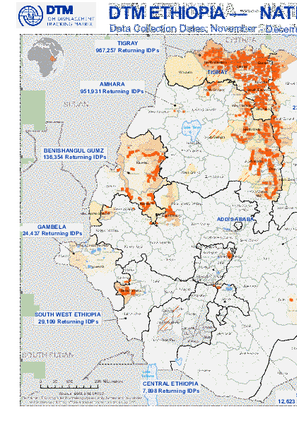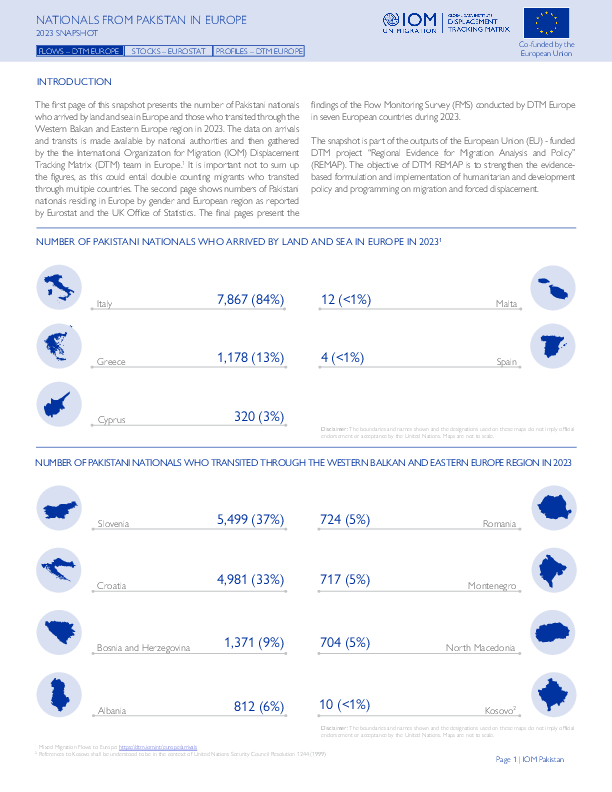-
Countries
-
Data and Analysis
-
Special Focus
-
Crisis Responses
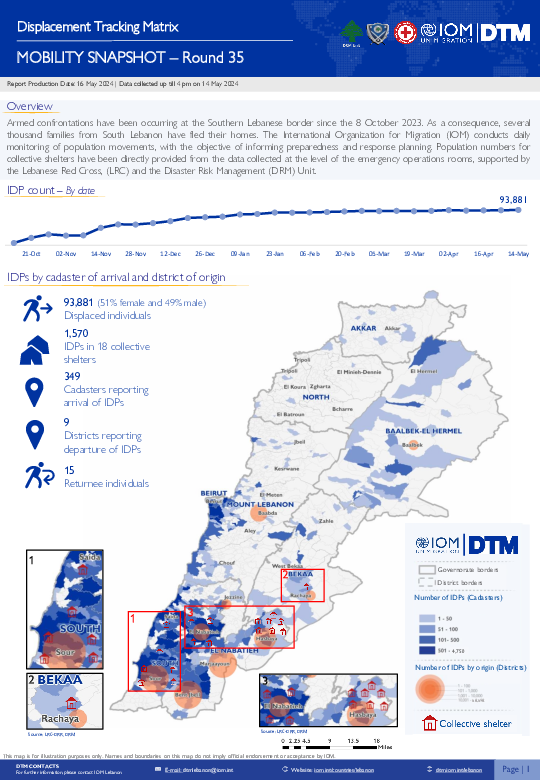
Contact
dtmlebanon@iom.int
Language
English
Location
Lebanon
Period Covered
Oct 10 2023
May 14 2024
Activity
- Mobility Tracking
- Baseline Assessment
Since October 8 there has been an increase in cross-border incidents between Israel and Lebanon, resulting in the displacement of people both within the South and elsewhere within the country. Since October 10, the Displacement Tracking Matrix (DTM) has been conducting the daily monitoring of population movements. The objective of the exercise is to inform preparedness and response planning.
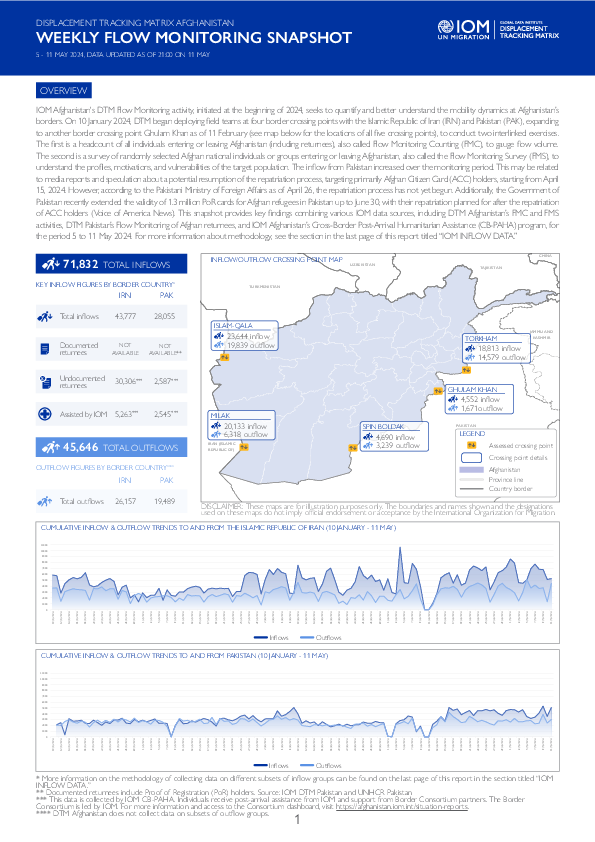
Contact
DTMAfghanistan@iom.int
Language
English
Location
Afghanistan
Period Covered
May 05 2024
May 11 2024
Activity
- Survey
- Flow Monitoring Survey
- Flow Monitoring
IOM Afghanistan's DTM Flow Monitoring activity, initiated at the beginning of 2024, seeks to quantify and better understand the mobility dynamics at Afghanistan’s borders. On 10 January 2024, DTM began deploying field teams at four border crossing points with the Islamic Republic of Iran (IRN) and Pakistan (PAK), expanding to another border crossing point Ghulam Khan as of 11 February (see map below for the locations of all five crossing points), to conduct two interlinked exercises. The first is a headcount of all individuals entering or leaving Afghanistan (including returnees), also called Flow Monitoring Counting (FMC), to gauge flow volume. The second is a survey of randomly selected Afghan national individuals or groups entering or leaving Afghanistan, also called the Flow Monitoring Survey (FMS), to understand the profiles, motivations, and vulnerabilities of the target population. The inflow from Pakistan increased over the monitoring period. This may be related to media reports and speculation about a potential resumption of the repatriation process, targeting primarily Afghan Citizen Card (ACC) holders, starting from April 15, 2024. However, according to the Pakistani Ministry of Foreign Affairs as of April 26, the repatriation process has not yet begun. Additionally, the Government of Pakistan recently extended the validity of 1.3 million PoR cards for Afghan refugees in Pakistan up to June 30, with their repatriation planned for after the repatriation of ACC holders (Voice of America News). This snapshot provides key findings combining various IOM data sources, including DTM Afghanistan’s FMC and FMS activities, DTM Pakistan’s Flow Monitoring of Afghan returnees, and IOM Afghanistan’s Cross-Border Post-Arrival Humanitarian Assistance (CB-PAHA) program, for the period 5 to 11 May 2024. For more information about methodology, see the section in the last page of this report titled “IOM INFLOW DATA.”
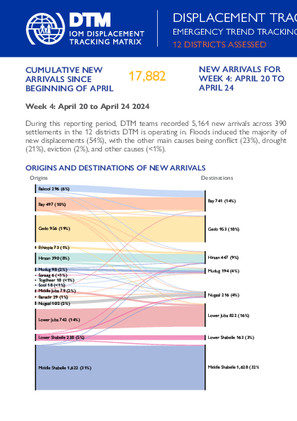
Contact
DTM Somalia, IOMSomaliaDTM@iom.int
Language
English
Location
Somalia
Period Covered
Apr 20 2024
Apr 24 2024
Activity
- Mobility Tracking
- Baseline Assessment
This latest round of Emergency Trends Tracking was initiated in April 2024 to monitor displacements movements during the Gu rainy season. Districts covered in this round include Afgooye, Afmadow, Baardheere, Baidoa, Balcad, Belet Weyne, Gaalkacyo, Garoowe, Jamaame, Jowhar, Kismaayo, and Luuq.
ETT is a crisis-based tool that tracks sudden displacement triggered by specific events or emerging crises. The objective of ETT is to help prioritize humanitarian response and to enable partners to deliver rapid assistance. Based on previous shock induced displacement patterns, the humanitarian community expects that people will continue to move toward urban areas in search of humanitarian services. Consequently, the ETT coverage focuses on the main urban centers and surrounding villages for each assessed district. The data is collected through Key Informant Interviews (KIIs) at the location level, from Sunday to Wednesday every week. It includes information on new arrivals, numbers and demographic of IDPs, reasons for displacement, intentions, humanitarian assistance and priority needs among others.
This report presents the main findings from the Displacement Tracking Matrix (DTM) Flow Monitoring Surveys (FMS) deployed in Greece, Italy, and Spain in 2023. FMS provide a snapshot of the profiles, experiences, and needs of migrants. The survey asks questions on demographics, education and employment backgrounds, the circumstances of the migration journey and migration factors, as well as future intentions and vulnerabilities to abuse, exploitation and violence.
In 2023, a total of 4,020 surveys were collected in 130 entry and transit points for migrants arriving by land and by sea to Europe. The report explores similarities and differences among migrants travelling along the Eastern Mediterranean Route (EMR), the Central Mediterranean Route (CMR), the Western Mediterranean Route (WMR) and the Western African Atlantic Route (WAAR) (3,626 surveys). A separate section also looks at the evidence from migrants interviewed in the North of Italy, entering by land from Slovenia (394), connecting this with analyses carried out in the Western Balkan (WB) region. A final section addresses the conditions and needs of migrant children (14-17 years old) in the sample.

Contact
DTMMozambique@iom.int
Language
English
Location
Mozambique
Period Covered
May 10 2024
May 14 2024
Activity
- Mobility Tracking
- Event Tracking
Between 10 to 14 May 2024, attacks, and fear of attacks by Non-state Armed Groups in Macomia triggered the cumulative displacement of 1,461 individuals/ 537 families. The current Movement Alert #112 reports on most recent attacks in Northen Cabo Delgado. For more information on displacements between January and April, please see {Emergency Tracking Online Dashboard}.
Between 23 November and 31 December 2023, IOM’s DTM deployed Site Assessment (SA) Round 35 and Village Assessment Survey (VAS) Round 18. SA is conducted in locations hosting a reported 20 or more IDP households, and the VAS is conducted in locations hosting a reported 20 or more returning IDP households that returned after 1 January 2022. It is to be noted that South Ethiopia region was not included due to operational constraints. The National Returns Map visualizes locations of return, density of return caseload, primary reasons for initial displacement, estimated return figures, and access constraints.
Contact
DTM Somalia Location
Somalia
Activity
- Mobility Tracking
- Event Tracking
Period Covered
Mar 30 2024 -Nov 13 2024
This latest round of Emergency Trends Tracking was initiated in April 2024 to monitor displacement movements during the Gu rainy season. From April to September 2024, DTM teams collected data in up to 22 districts: Afgooye, Afmadow, Baardheere, Baidoa, Balcad, Belet Weyne, Belet Xaawo, Cabudwaaq, Dayniile, Dhuusamarreeb, Doolow, Gaalkacyo, Garoowe, Hobyo, Hodan, Jamaame, Jowhar, Kahda, Kismaayo, Luuq, Waajid, and Xudur. Starting week 28, data collection occurred in the 4 districts: Waajid and Xudur districts in Bakool region and Gaalkacyo and Hobyo districts in Mudug region.
ETT is a crisis-based tool that tracks sudden displacement triggered by specific events or emerging crises. The objective of ETT is to help prioritize humanitarian response and to enable partners to deliver rapid assistance. Based on previous shock-induced displacement patterns, the humanitarian community expects that people will continue to move toward urban areas in search of humanitarian services. Consequently, the ETT coverage focuses on the main urban centers and surrounding villages for each assessed district. The data is collected through Key Informant Interviews (KIIs) at the location level, from Saturday to Wednesday, every week. It includes information on new arrivals, numbers and demographic of IDPs, reasons for displacement, intentions, humanitarian assistance and priority needs among others.
To facilitate the joint analysis of the CCCM (Camp Coordination and Camp Management) Cluster’s New Arrivals Tracker (NAT) and ETT data, the assistance and needs indicators are identical in both tools.
Population Groups
IDPs
Survey Methodology
Unit of Analysis Or Observation
Site or Location
Type of Survey or Assessment
Key Informant
Keywords
Geographical Scope Partial Coverage
Administrative boundaries with available data
The current dataset covers the following administrative boundaries
This snapshot on nationals from Pakistan in Europe is part of the outputs of IOM’s EU-funded Displacement Tracking Matrix - Regional Evidence for Migration Analysis and Policy (DTM REMAP) project. The snapshot is divided into three sections:
Firstly, it provides information on the number of Pakistani nationals who arrived by land and sea in Europe and those who transited through the Western Balkan and Eastern Europe region in 2023. The data on arrivals and transits is made available by national authorities and then gathered by the IOM DTM team in Europe.
Secondly, it delves into the demographic distribution of Pakistani nationals residing in Europe, categorized by gender and geographical regions within Europe, utilizing data reported by Eurostat and the UK Office of Statistics.
Lastly, the report encapsulates the insights gained from the Flow Monitoring Survey (FMS) conducted by the DTM Europe team, engaging with 373 Pakistani nationals across seven European countries throughout 2023.
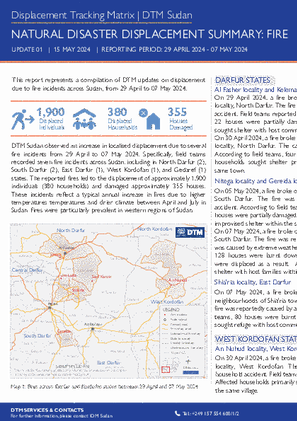
Contact
DTM Sudan, SudanDTM@iom.int
Language
English
Location
Sudan
Period Covered
Apr 29 2024
May 07 2024
Activity
- Other
Following the increase in localized displacement due to fires, DTM Sudan released the following report summarizing DTM updates on displacement due to fire incidents across Sudan, from 29 April to 07 May 2024.
DTM field teams reported seven fire incidents across North Darfur (2), South Darfur (2), East Darfur (2), West Kordofan (1), and Gedaref state (1). Some fires were reportedly caused by increased temperatures and drier climate conditions, while others were due to household accidents.
Highlights
- Fires displaced an estimated 1,900 individuals (approximately 380 households) between 29 April and 07 May 2024.
- Over 355 houses were partially damaged or destroyed by the fires.
- The fires resulted in localized displacement: the majority of displaced households sought shelter with host communities within the same locations.
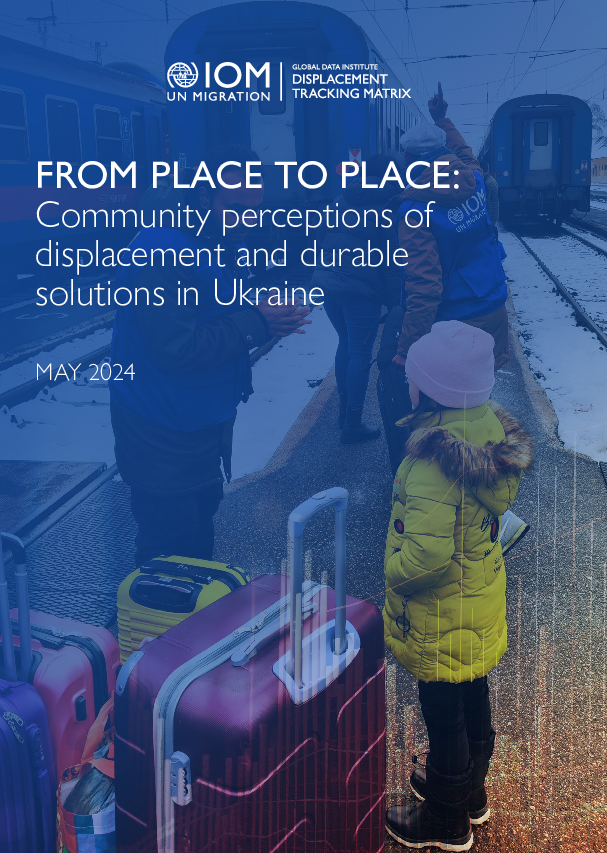
Contact
DTM Ukraine, dtmukraine@iom.int
Language
English
Location
Ukraine
Period Covered
Feb 12 2024
Mar 15 2024
Activity
- Other
The War in Ukraine has caused massive displacement, with about 3.7 million people forced to flee their homes, land, and families. Most of them want to go back to where they came from, underlining the pressing need for a recovery and transition strategy that links humanitarian and development efforts, addresses the immediate needs of the communities affected by displacement, and prepares them for their collective future. Aware of this necessity and in line with the global action on internal displacement, the Ukrainian government, the UN, and partners are implementing a comprehensive recovery and transition plan that prioritises data-based approaches and participation so that the displaced people and their host communities can shape and achieve lasting solutions to their displacement.
This research report examines the views of the displaced and their hosts to understand their experiences, hopes, and preferences for durable solutions. It provides useful insights to inform the creation of a 'Joint Analytical Framework' in Ukraine to track progress towards solutions pathways and guide future policies and programs.

